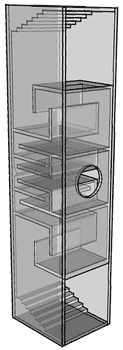|
|
|
| |
|
|
|

Terry Cain DoubleBEN
|
05_may_2012
Inspired by the
Frugel-Horn project, we decided to pursue a new range of frugal enclosures. For these
cabinets, rather than using corner-loading, we wanted to utilise the double mouth
layout pioneered by Terry Cain in his beautiful Double BEN (Big ENough) horns.* The result was the Spawn
series of cabinets depicted on these pages. These are split into two distinct subsets,
the Olson-Nagaoka enclosures and the BVRs. |
|

Lotus2
|
| |
|
|
| The primary reason for
employing the over-under mouth configuration, other than for the aesthetic effect,
is that it allows a larger horn for a given footprint, and provides a rather different
power-response to most single-mouth designs, analogous to a large MTM with a low
crossover frequency. Terry's comments after building his original Double BEN enclosures
still make interesting reading, and give some idea as to the sonic character the
layout can provide: 'The design works to stretch the sweet spot considerably.
I knew this would add depth, and it does, in spades... The sound, punchier, deeper,
better balanced. Imaging is magnificent. It's a lot of woodwork but makes cellos
and pianos have enough weight to the sound. From the first song I heard on these
I knew they had something really amazing. Drums and double bass are doubly good.' |
| |
|
Olson-Nagaoka Cabinets --
Kongo, Haruna & Kirishima
These cabinets employ
manifold, rather than constant expansion. In such designs, the horn flare is created
by an cascade of untapered manifolds of increasingly greater cross-section. This
approach is most often associated with Mr. Tetsuo Nagaoka, one of the great figures
in Japanese speaker design, who produced a vast number of cabinets over several decades,
mostly for Fostex drive units. However, it was first suggested by the legendary Harry
Olson, in his 1937 patent application (granted 1940). Although not
discussed in particular detail in the application, which focused upon the marrying
of a low-pass filter (chamber) to a horn rather than the expansion of the horn itself,
the diagrams clearly illustrate the first known instance of this expansion method,
and references are to be found in the text, hence our respectful name-checking of
both men. Although this type of cabinet does tend to require a large number of panels,
they are relatively easy to construct since there are no complex angles to cut or
position, and they are typically very efficient in how they use space, allowing a
longer / larger horn for a given cabinet dimension. The sharp internal edges and
angles also provide an additional low-pass filter, disrupting and attenuating unwanted
shorter wavelengths passing along the horn. In ascending order of size, the cabinets
are:
|

|

|

|
|
|
|
|
Kongo
for
FE126En
|
Haruna
for
FE166En
|
Kirishima
for
FE206En
|
|
| |
|
|
|
moose BVR -- now in Generation
3
At present, the majority
of our earlier BVR designs are obsolete owing to the drivers they were developed
for being discontinued. Several are currently in development for new currently available
units.
The BVRs are essentially
horn loaded reflex enclosures, viz. a bass reflex cabinet, with a short, carefully
profiled horn replacing the more usual vent tube or duct. Cosmetically, they look
like any other horn and output is over a broader bandwidth than is usual for more
conventional vented boxes. The type was once relatively popular, with Klipsch, EV,
Jensen and others all producing boxes using variations on this loading scheme. Like
many others, it fell out of favour when the availability of cheap transistor power
during the 1970s resulted in a shift toward lower efficiency speakers in smaller
enclosures. With the resurgence of interest in high[er] efficiency speakers, this
type of design is again being explored, two notable recent examples being the Replikon horn, and Onur Ilkor's double-mouth enclosure.
|

|

|

|

|
|
|
|
|
|
Derwent
EL70
|
Coniston2
2 x
EL70
|
Freddie
for
DNF5
|
Lotus
for
CHR70
|
| |
|
|
|
|
Note:
all these visualizations shown with optional slanted deflector which requires an
angle cit at each end.
|
|
| |
|
|
Like the Frugel-Horn,
these cabinets are made freely available for DIYers to build for personal use. Builders
are encouraged to contribute at least feedback. Commercial builders are required
to fulfil a (very) few requirements: Use of Designs
Please note: all of the enclosures on this page were refined in Martin J. King's MathCAD worksheets.
Thanks are due in particular to Greg Monfort for his advice, and to all other DIYers
who have built these designs and their predecessors.
*Sadly, our friend Terry
Cain passed away in December 2006. He is sadly missed by many, not least the audio
community.
|
|